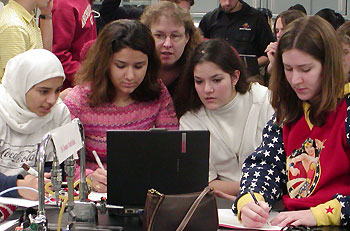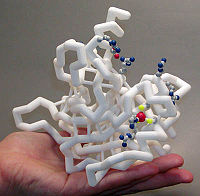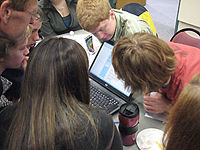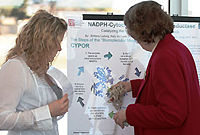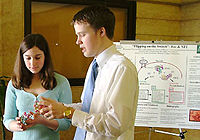Group:SMART:Teams
From Proteopedia
Contents |
Overview of the Program
What do you get when you combine enthusiastic high school teachers and their students, scientists excited about their research, and Rapid Prototyping technology? SMART (Students Modeling A Research Topic) Teams! In this multi-faceted program, students develop teamwork as they delve into the molecular world, explore science as a process and not just a collection of facts, and work closely with a researcher to understand and model the structure-function relationship of a protein the researcher studies. After designing and building a model of the protein using Rapid Prototyping technology, SMART teams create an oral presentation explaining their work to a lay audience and a poster which is presented to a scientific audience.
SMART Teams consist of a teacher who has participated in the Center for BioMolecular Modeling's summer course, Modeling the Molecular World, Part I (or its predecessor, Genes, Schemes and Molecular Machines), students, and a research mentor.
Qualification, Research, and Presentation Phases
Teams work to complete the three phases of the program:
Qualification Phase
Students review basic concepts of protein structure and are introduced to the use of molecular visualization software (RasMol) to generate virtual images of proteins based on atomic coordinates obtained from the Protein Data Bank. Each Team then demonstrates their knowledge of these topics by designing and building a physical model of a protein that is currently in the news. This phase of the program ends with the Qualification Exam, a friendly yet competitive event in which Teams compete to demonstrate their expertise in all areas related to the physical modeling of molecular structures.
Research and Model Design Phase
Qualified SMART Teams are then matched with a research scientist who is investigating a specific protein in their laboratory. The matching of Teams and mentors is accomplished through a “speed dating” activity in which all the Teams meet all of the potential mentors in a series of intense five-minute conversations. Compatible Teams and mentors are matched following this activity.
Once matched, the Team visits the mentor’s laboratory and learns about their research project. The Team identifies a protein that is the focus of the lab’s research project, and then designs a physical model. During this research and design phase, the Team works closely with the mentor to create a physical model that will be useful as a “thinking tool” in the laboratory.
Presentation Phase
Following the design and construction of the physical model, the Team continues to work with their mentor and teacher to develop a short oral presentation of their work for a lay audience, and a poster that is presented in a poster session within the scientific community. Some teams also present their posters to their local PTA or school board, or at a scientific research meeting, such as ASBMB or ASM.
SMART Team Proteopedia Pages
Wisconsin SMART Teams
2008-2009
A SMART Team Molecular Story - Madison West High School Project of β2-Adrenergic Receptor
A SMART Team Molecular Story - Community SMART Team of Southeast Wisconsin Project of GNNQQNY from Yeast Prion Sup35
2009-2010
HHMI SMART Teams
2008-2009
2009-2010
US SMART Teams (outside of Wisconsin)
2007-2008
Tangible Models of Cdc42 Interacting With Intersectin
2008-2009
2009-2010
A SMART Team Molecular Story - Hostos-Lincoln Academy, NYC: Project on Acetylcholinesterase Substrate Traffic and Inhibition by Green Mamba Snake Toxin
Proteopedia Page Contributors and Editors (what is this?)
Mark Hoelzer, Joel L. Sussman, Eric Martz, Kurt Giles, Allison Granberry, David Stack, Jaime Prilusky
